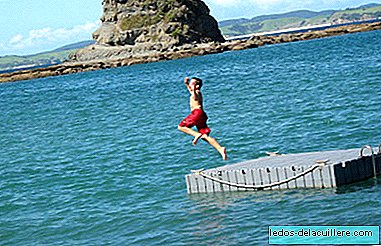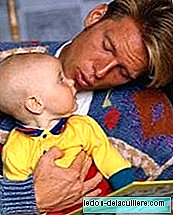
An oversight can be the origin of an unfortunate accident that forever changes the life of a family. We see it every year when it starts to get hot and the community or public pools open, when the private pools are cleaned and refilled, and when families move to the beaches to take the first bath.
In general it is estimated that the second cause of accidental death in children under nine years of age is drowning by immersion (The first, as we know, is traffic accidents). Within that age range, the most susceptible to suffer these types of accidents are children from four to seven years (parents trust us: 'have you gone to swimming lessons ?, I relax'). Obviously, we monitor babies more, and children aged eight or nine tend to have more physical resistance, but shouldn't we combine the ability to function in the water to common sense?
And how to ask common sense to some people who - by age - have as their main objective pleasure through play? It is necessary to remember that fathers, mothers, caregivers, grandparents, uncles, etc. they should watch the children while they bathe. Watch, or monitor, as you wish, but the case is that a few seconds are enough for the child to disappear from our sight, it is enough a few minutes (less than five) for the brain cells to die due to oxygen deprivation, and for vital organs suffer irreparable damage.
Supervising is not telling children how to play, but yes be aware of your movements even from a distance. When I go to the beach with my children and I am alone, I do not bathe, I remain motionless in the sand looking at them and I am not distracted under any circumstances. Have you seen reports about meerkats? Well, I do that, take care of them, in our case there are no predators but water can also kill.

And supervising is also talking to them beforehand and explain that bathing in the water is fun, but starting risky behaviors can be the cause of accidents with uncertain end and probabilities that it is irreparable. An example of these behaviors are the 'chokes'.
For some a game, for others a 'let me see when this heavy joke of my friends ends'. But the point is that children can 'go hand in hand', and what they intended to be a few moments with the friend's head under water, become one or two minutes based on 'pushing the other into the water, and when it comes out I put it back in'.
Causes of drowning by immersion in older children
If we had said that children between four and seven years suffer from this type of accident with greater probabilities, in higher ages they are not exempt. For example between eight and 12 years they rely excessively on their abilities, and they also want to show off in front of their friends (to see who dives the longest, to see who makes the biggest jumps to jump into the pool, to see who resists pushing others more).
Teenagers are also considered a vulnerable group, especially if they dive under the influence of alcohol, or when practicing recreational activities or water sports in rivers, lakes or at sea, regardless of their own limitations or safety measures.
Accident prevention experts agree that one of the most dangerous moments occurs after meals, adults can relax or be distracted, while the child goes out to look for water again
Objective: avoid accidents
It would be convenient for us to review this decalogue of the National Child Safety Association, but in addition, children should get used to warning (or asking permission) before getting into the water. So, on the one hand we are knowledgeable (Just as they tell us 'I'm going with my friends to the bicycle circuit'), and on the other we can tell them to wait a little while they just ate and they could use some rest.

We must remind you that the edge of the pool does not run, and that pushing others is not a joke, which can end badly. It is also good that we talk about living in public swimming pools, for example: before throwing ourselves on a trampoline, we must see that there is no one nearby to not hurt. We adults must behave responsibly, we will not do the opposite of what we say, and create confusion in our children.
In the sea, rivers, lakes, there are added risks such as the fact that shallow depth (which is often not known in advance) can cause serious injury when children throw themselves head first.
There is nothing to replace adult surveillance, not even vests or other physical measures that keep the child afloat
How do we act in an accident?
First of all, remember that Although we want to help those in distress, we must first preserve our own integrity, and this is important for children to know in case they must one day make a decision. In many cases the best help will be to call the rescue services and there are many examples (we do not know how to swim, there is a lot of waves, the accident has fallen into the river and we fear the current).
Definitely: a rescue must be carried out by specialized personnelAnother thing is that I see a child in difficulties in the pool or on the beach near the shore, and (making sure that mine are out of the water and nothing will happen to them), take it out. The best help for the injured is a person who knows how to act and who does not put himself in danger.
Because in addition to notifying the lifeguard, or calling Emergencies, taking out the victim is a priority. And always preventing the neck from flexing, also if we know how to perform resuscitation maneuvers, we apply them.
So you know: enjoy summer and water, but always with caution, and transferring this to children.
Images | Nathan Torkington, USAG- Humphreys, Kathy In Peques and More | A review of drowning prevention strategies, Preventive measures are the best tool to reduce the rate of infant deaths in swimming pools, Enjoy water and avoid risks, Guide for families












